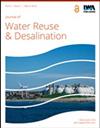A pilot-scale anaerobic moving-bed biofilm reactor with PVA gel beads as media for the treatment of fish canning industry wastewater
IF 2.3
Q2 Environmental Science
引用次数: 3
Abstract
This research aims to investigate the performance of a pilot-scale anaerobic moving-bed biofilm reactor (AnMBBR) using PVA gels as media for the treatment of real wastewater from a fish canning factory. The chemical oxygen demand (COD) removal efficiencies at different organic loading rates (OLRs) were investigated at 3.0, 4.3, 6.5, and 8.7 kg COD/m3day by adjusting the flow rates to 350, 500, 750 and 1,000 L/d, respectively. The soluble COD removal efficiencies of the system at flow rates of 350, 500, 750, and 1,000 L/d were 81.0 ± 12.4%, 76.8 ± 8.2%, 74.7 ± 6.2%, and 70.6 ± 12.4%, respectively. According to the residence time distribution (RTD) tests at the highest and lowest flow rates, the mean residence times of both flow rates were significantly higher than the theoretical residence time, indicating very strong external recirculation inside the AnMBBR. The results suggest a 3-pass flow pattern through the AnMBBR. From 16S rRNA gene amplicon sequencing (MiSeq, Illumina) and scanning electron microscopy (SEM) analysis, Methanosaeta, acetoclastic methanogens, were the predominant microorganisms in the system. Most of the microorganisms were located within a 1.994 ± 0.266 mm depth from the PVA gel surface, with two distinct layers.PVA凝胶珠厌氧移动床生物膜反应器处理鱼罐头工业废水的中试研究
本研究旨在研究以PVA凝胶为介质的中试厌氧移动床生物膜反应器(AnMBBR)处理鱼罐头厂实际废水的性能。通过将流速分别调整为350、500、750和1000L/d,研究了在3.0、4.3、6.5和8.7kgCOD/m3的不同有机负荷率下化学需氧量(COD)的去除效率。在流量为350、500、750和1000L/d时,该系统的可溶性COD去除率分别为81.0±12.4%、76.8±8.2%、74.7±6.2%和70.6±12.4%。根据最高和最低流速下的停留时间分布(RTD)测试,两种流速的平均停留时间都显著高于理论停留时间,表明AnMBBR内部有非常强的外部再循环。结果表明,通过AnMBBR的流动模式为三级。从16S rRNA基因扩增子测序(MiSeq,Illumina)和扫描电子显微镜(SEM)分析来看,甲烷菌是该系统中的主要微生物。大多数微生物位于距离PVA凝胶表面1.994±0.266 mm的深度内,具有两个不同的层。
本文章由计算机程序翻译,如有差异,请以英文原文为准。
求助全文
约1分钟内获得全文
求助全文
来源期刊

Journal of Water Reuse and Desalination
ENGINEERING, ENVIRONMENTAL-WATER RESOURCES
CiteScore
4.30
自引率
0.00%
发文量
23
审稿时长
16 weeks
期刊介绍:
Journal of Water Reuse and Desalination publishes refereed review articles, theoretical and experimental research papers, new findings and issues of unplanned and planned reuse. The journal welcomes contributions from developing and developed countries.
 求助内容:
求助内容: 应助结果提醒方式:
应助结果提醒方式:


